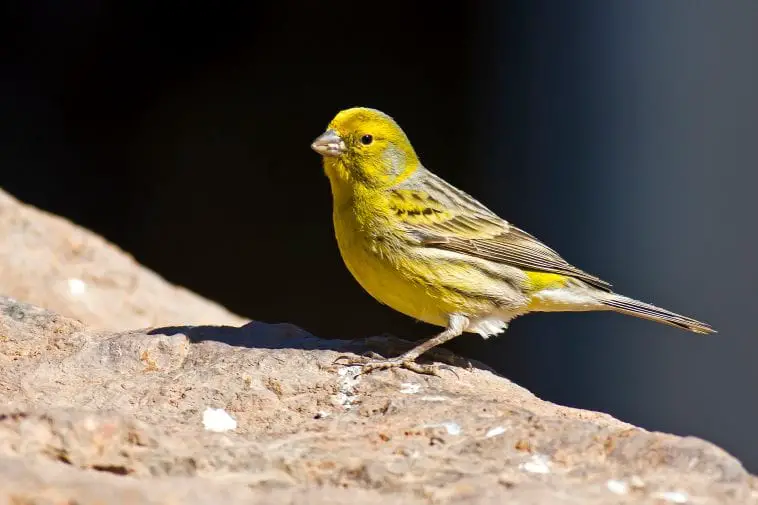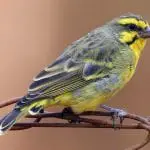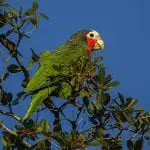Scientific Facts
| Common Name | Atlantic Canary |
| Scientific Name | Serinus canaria |
| Lifespan | 8 – 20 Years |
| Size | 3.9 – 4.7 inches |
| Mass | 0.30 – 0.86oz. |
| Habitat | A wide variety of natural and man-made habitats, mostly semi-open areas |
| Origin | Macaronesia region in the eastern Atlantic Ocean |
Information & Physical Description
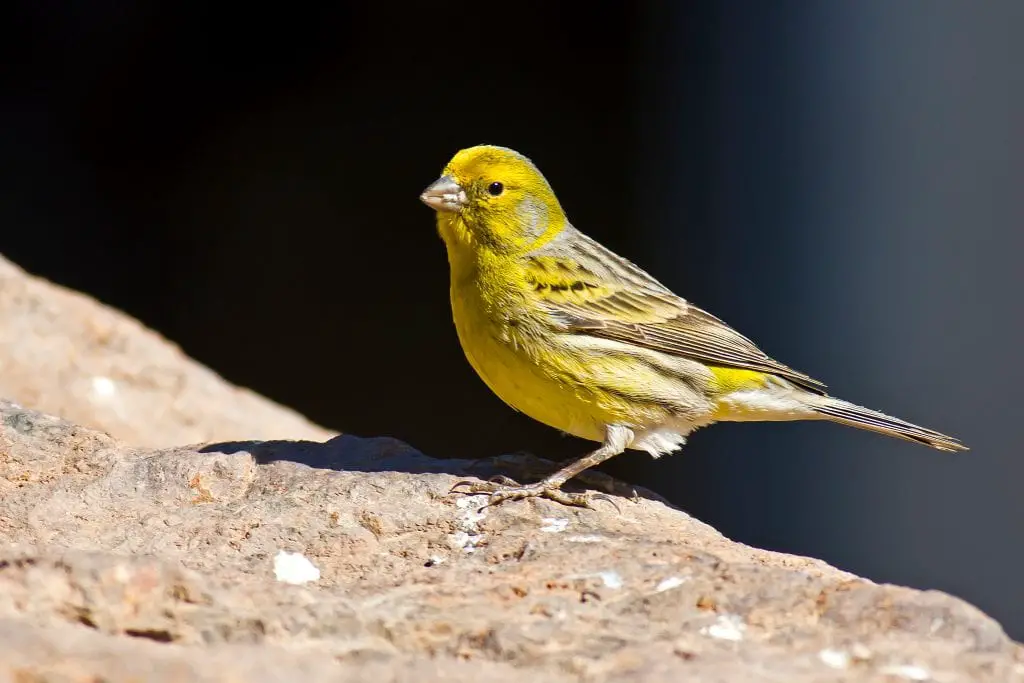
Scientifically referred to as Serinus canaria, the Atlantic Canary is also commonly known as a wild canary, island canary, and common canary.
Ranging from 3.9 to 4.7 inches in length, the roundish-bodied Atlantic canaries usually weigh approximately 0.53oz. Their wingspan can reach from 8.3 to 9.3 inches in length.
In comparison to its relative, the European serin (aka serin), the Atlantic canary is about 10% longer and larger, as well as less contrasted, with relatively shorter wings and more brown and grey in its plumage.
These beautiful living creatures are described as small songbirds possessing fairly heavy bills, as well as forked, relatively long tails.
The head, as well as the underparts of the male Atlantic canary, are mostly colored in yellow-green, with the face, supercilium, and forehead being yellower in color. Meanwhile, the upper parts are colored in grey-green, as opposed to the undertail-coverts and lower belly zone being whitish in color.
Female Atlantic canaries are quite similar to males; however, females are generally visibly duller, with the head and breast zone being greyer in color. Also, with females, the underparts are less yellow, as compared with males.
The body coloration of juvenile Atlantic canaries is predominantly brown, with dark streaks.
Originally, the Atlantic canary was classified as a subspecies of the European serin, and both were assigned to the genus Fringilla. However, it was decades later that the Atlantic canary was reclassified by Cuvier into the genus Serinus, and it is in this genus where these birds remain up-to-date.
Contrary to wild Atlantic Canaries, domestic canaries come in a vast range of colors, such as brown, black, white, yellow, and red, among others.Also, domestic varieties have different types of plumage featuring diverse crests on the head zone, and nonetheless, other ruffled feathers elsewhere on their bodies.
Lifespan

In the wild, the Atlantic canary is known to live for about 8 years. However, in captivity, these birds can live up to 20 years, as long as they are given the proper care. On average, the canaries’ captive lifespan is estimated at 14 years.
Ecosystem & Habitat
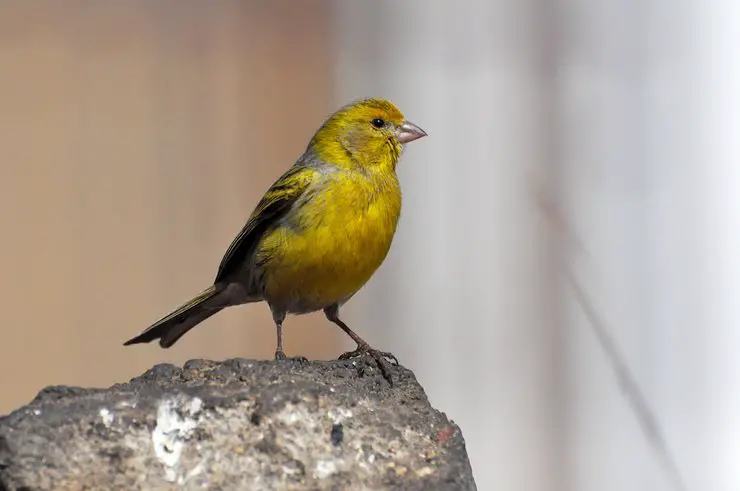
Just like their name suggests, Atlantic canaries are endemic to the Canary Islands. Also, they are endemic to Madeira and Azores, and altogether with the Canary Islands, these areas make up the Macaronesia region located in the eastern Atlantic Ocean.
In the Canary Islands, Atlantic canaries are common on El Hierro, La Gomera, Tenerife, and La Palma, at an altitude of up to 1500 meters above the sea level, with their local populations being more common on Gran Canaria, as compared to Fuerteventura and Lanzarote where these birds had just recently started breeding.
In Madeira, Atlantic canaries are common in the Desert Islands and Porto Santo, from sea level to at least 760 meters above the sea level elevations,while in the Azores, these birds are common on all the islands, from sea level to 1,100 meters above the sea level.
Atlantic canaries are known to occupy a relatively wide variety of different types of habitats. Some of the ecosystems inhabited by these beautiful birds include coastlines, sand dunes, woodlands, forests, forest edges, and orchards, among others.
Different populations of canaries in the wild live everywhere, starting from sea level to up to about 5,000 feet (respectively,around 1500 meters) above the sea level.
Being well-adaptable to interacting with humans, Atlantic canaries are also known to often live in backyards, gardens, and parks, among other man-made habitats.
Furthermore, canaries are quite common and desirable visitors at birdfeeders within their native range.
Behavior

Atlantic canaries have the reputation of being extremely sociable finches. They seem to enjoy perching on trees, where they can sing their wonderful, sweet songs all year-round.
Island canaries are commonly seen in joint flocks consisting of Common Linnet and European Goldfinch.
All canaries, regardless of whether it comes to those in the wild or those raised in captivity, are diurnal creatures, meaning that they are active during the day and asleep at night.
The canaries spend their time in pairs or in small groups, engaged in foraging activities. Some will feed directly in trees or bushes, while others will forage the ground in search of fallen seeds.
Contrary to other songbirds, Island canaries do not leave the bigger flocks with the approach of the breeding season, but instead, they are known to nest together in mini-colonies, with each pair having its very own small territory around the nest.
Reproduction
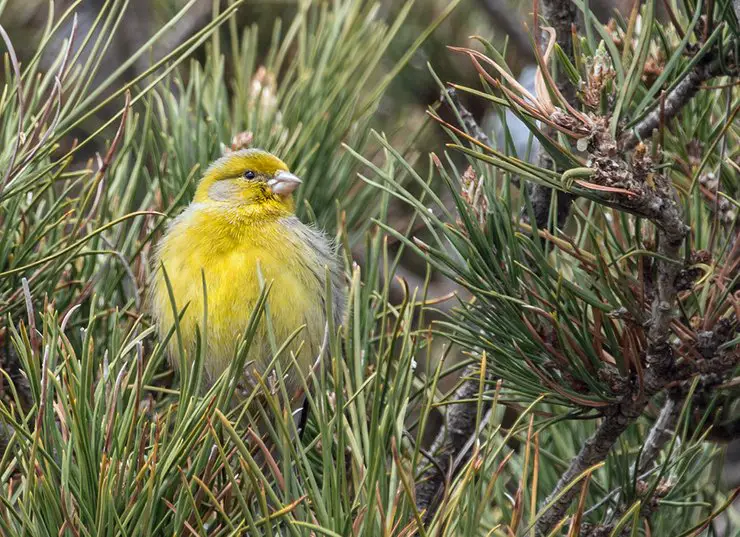
Atlantic canaries are gregarious birds, commonly nesting together in groups. The shape of the nest resembles a cup and is built between 1 and up to 6 meters above the ground (typically, 3 – 4 meters above the ground), in a bush or in a tree.
The nest is made out of moss, grass, and twigs, among other types of plant material available in the wild. Also, it is further lined with soft materials, such as feathers and hairs.
By building the nest at the very end of a branch or in a fork, it remains perfectly camouflaged among the leaves of trees and bushes.
Atlantic canaries lay their eggs at different times of the year based on local populations. For instance, in the Canary Islands, eggs are laid at some point between January and July. In Madeira, eggs are laid between March and June, while in the Azores, they are laid between March and July.
Two and up to three broods of Atlantic canaries are raised every year, with a single clutch consisting of three and up to five eggs. The eggs are spotted with reddish or violet markings, mostly concentrated at the broad end of the egg, while the main coloration is blue-green to pale blue.
The incubation period lasts for about two weeks. Young Atlantic canaries are ready to leave the nest after 15 – 21 days.
Food & Diet

In the wild, Atlantic canaries are to typically feed in flocks. The diet of these primarily herbivorous birds mainly consists of various seeds, such as those of grasses, shrubs, trees, and weeds.
Atlantic canaries do also feed on other plant material, such as fruits, and in particular figs. Furthermore, they occasionally eat small insects and invertebrates, too, like spiders, beetles, grasshoppers, mosquitoes, and flies, to name a few.
As a rule of thumb, canaries need gravity in order to swallow their food, and because of this, when introduced to zero-gravity conditions, canaries have been found to die due to the associated dehydration.
The feeding routine of domestic canaries consists of a variety of fresh fruits and vegetables, as well as commercial-grade pelleted diets.
Possible Health Issues
1. Mite infection
As a rule of thumb, mite infection is fully treatable, as long as it is caught and addressed in a timely manner. Because of this, caregivers need to be proactive in contacting a qualified vet as early as any suspicions on possible mite infections are to arise.
The canaries are known to be susceptible to scaly mites, air-sac mites, red mites, and feather mites.
Scaly mites show as a scaly buildup located around the eyes, legs, and/or beak.
Feather mites and red mites are a type of nocturnal mites that feed on the canary’s blood once they crawl out during the night.
Air-sac mites are exclusively to occur in the respiratory system of the bird.
2. Canary pox
Canary pox is a mosquitoes-transmitted virus. This virus poses a serious threat to these birds’ health, and that’s especially if the birds are housed outdoors since the chances for canary pox are significantly increased in this case. The highest infection rates occur during the summer months when mosquitoes are plentiful.
Human Interaction & Domestication
Flitting frequently in parks, as well as in backyards while searching for food, Atlantic canaries, and humans do interact on a frequent basis.
Even though humans are known to affect different canary species in different ways, some of which are not really positive, as the populations of Atlantic canaries are quite healthy and stable, these canary species actually thrive in a variety of man-made and/or human-altered habitats alike.
Thanks to backyard bird feeders and being able to live in urban areas, Atlantic canaries thrive not solely and exclusively as solitary birds in the wild. In fact, ever since selective breeding began back in the 17th century, humans have managed to successfully domesticate the Atlantic canary.
Housing

Domesticated varieties of the Atlantic canary are typically completely yellow in color, and they also tend to sing much more, as compared to their relatives in the wild, and both of these desirable features, altogether with their low-maintenance care requirements, have kept the Atlantic canary as one of the most popular pets worldwide.
1. To house an Atlantic canary the right way, make sure to purchase the largest cage that you can possibly afford to accommodate in your house/backyard. A large cage will provide the security and space these birds need to thrive.
2. The cage must be as large as feasible to allow the birds to fly since this is crucial for the maintenance of both their happiness and health alike.
3. Do NEVER clip the wings of your canary to “help” the bird fit into a cage of selected size!
4. The best type of cages for domestic Atlantic canaries are flight type cages. These can be commercial-grade or DIY types. Keep in mind that a long cage is more important (and more appropriate), as compared with a tall and narrow cage. Ultimately, it is the length that is the most important factor in choosing/building a suitable cage, since it is the length of the cage that allows the bird to fly naturally well, and not the height.
5. As a rule of thumb, it is best to ensure a cage that is at least 24 inches in length. The spacing between the bars should be not any more than ½ inch.
6. Wire cages are strongly recommended. Bamboo, as well as wood cages, are quite difficult to maintain clean.
7. The canaries feel comfortable in the same temperatures that a human feels comfortable with. Thus, keep the temperature near the cage at room temperature for the best results.
8. Keep the canary’s cage away from windows, air conditioners, or any other possible sources of drafts that can cause temperature extremes.
9. Do not keep canaries late up using artificial lights. The canaries require a light/dark cycle that mimics the day and night and approximates natural changes. It is best to cover the cage at the time the sun goes down.
10. One of the most important additions to a canary’s cage is perches. Provide smooth, slightly irregular perches, so that the Atlantic canary will be able to comfortably and easily grasp the perch. Sandpaper perch covers should NOT be utilized.
11. The canaries may enjoy toys, such as mirrors, bells, swings, and/or hanging acrylic/wooden toys. However, never place the toys in such a manner as to get the bird’s flight space obstructed!
Temperament
Most Canaries, including the Atlantic canary, tend to be more of shy, timid birds to keep as pets.
Atlantic canaries, like other canaries in general, dislike being handled. However, there might be occasional exceptions on that note.
Atlantic canaries are charmingly tempered birds, as many are reported to enjoy interacting with their caregiver, as well as to simply enjoy watching their caregiver from the comfort of their cozy flight cage.
Mind that canaries may be very territorial, though. Dominant behavior may be hard, if possible at all, to control, as it can lead to very unfortunate, unwanted consequences for the submissive Atlantic canary in the group. With this in mind, it is a must to use caution in the case of keeping more than one single canary in the cage.
Cool Facts

1. Together with the Canary Island date palm, the Atlantic canary is a natural symbol of the Canary Islands.
2. The canaries are named after the Canary Islands and not vice versa.
3. Back in time, canaries were used as a warning system in coal mining, since they would provide excellent audible evidence for toxic gases by stopping to sing, thus, saving the lives of the miners.
4. The famous animated character, Tweety bird, is inspired by the domesticated Atlantic canary!
Availability – Where to get an Atlantic Canary?
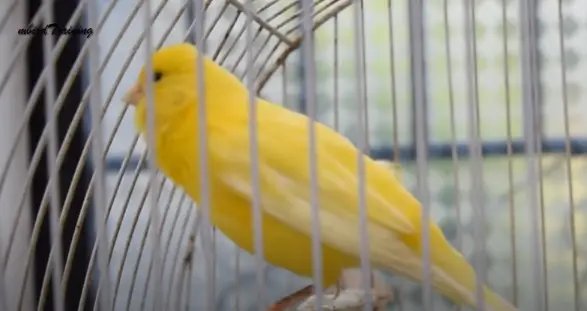
Atlantic canaries are available to purchase from a variety of reputable pet stores. Also, you can choose to get an Atlantic canary directly from a trustworthy breeder, as well as from avian-specialty shops.
When it comes to possibly adopt a canary from avian-rescue organizations, doing so is less likely to help you get an Atlantic canary pet, as these organizations are mostly focused on other bird species that need homes, especially parrot species.
How to Care for the Atlantic Canary

1. Feed your Atlantic canary with a balanced variety of veggies and fruits. Also, feed them with high-quality, commercially produced pellet diets. Provide fresh water available at all times.
2. In the case, the bird shows any signs of illness, contact a qualified veterinarian immediately.
3. The Atlantic canary’s small, cute stature, usually makes this bird seem like one of the best choices when it comes to children-friendly pets. However, it is important to note that canaries are very easily frightened, they are not really a “hands-on” type of bird pet, and they are also very fragile, so keeping them in a home with very young kids may not be the best idea.
4. For beginner bird pet owners, as well as for bird pet enthusiasts who don’t have plenty of free time to take care of their feathery companion, Atlantic canaries can make an excellent choice, as they do not require a great deal of attention.
5. Even though canaries are known to be happiest when in pairs, for those who cannot afford to accommodate a cage large enough to house a pair, keep in mind that even a single canary can be happy and healthy when provided the right care, as canaries are generally not very social.
6. While providing commercial-grade pelleted food is fine, mind that a top-quality seed mixture is a much more palatable mainstay diet for the Atlantic canary. To give the birds some variety, it is best to keep a small dish with a combination of seed mixture and pelleted mixture.
7. Suitable fresh greens and foods to feed to your Atlantic canary include green peppers, bananas, canned corn, oranges, apples, cooked broccoli, fresh corn-on-the-cob, raw collard greens, dandelions, spinach, and Swiss chard, cucumbers, squash, peaches, pears, strawberries, and small bits of hard-boiled eggs.
8. For a special treat, freshly sprouted seeds make a fantastic option.
9. Do note that at a quick glance, the dish full of seed mixture may appear full; however, it is actually only the hulls left after the bird has eaten the seeds. Make sure to blow the hulls off the dish on a daily basis, and then replenish the seeds as needed.
10. Canaries’ nails need to be trimmed, so you can help this process all naturally by using rough concrete perches where these birds’ nails will wear on their own. However, every now and then, you will still have to bring your canary to the vet to get its nails carefully trimmed.
11. When covering the cage as the sun goes down to allow the Atlantic canary to get its vital dose of sleep, only cover the cage with a light cloth and do not forget to remove the cloth in the morning. Some canaries are known to panic if left in total darkness.
FAQ Section
Do the Canaries Make Good Pets?
Yes, canaries make good pets, especially for people who do not have much free time, since these birds do not require lots of affection or attention. However, canaries do need to be provided with a clean environment, as well as ample water and fresh food available at all times.
Do Canary Birds Come from the Canary Islands?
The domestic canary birds are domesticated forms of the wild canary, also known as Atlantic canary or Island canary. Wild canaries originate from the Macaronesian Islands, which include the Canary Islands, as well as the Azores and Madeira.
What Does the Atlantic Canary Symbolize?
Atlantic canaries and other canaries alike are believed to symbolize freedom, intellectual development, joy, and well-being.
What Does it Mean if a Canary Visits You?
If a Canary is to visit you, it is believed that this is a symbol of joy and happiness, as well as the inner power of having the patience to enlighten yourself and others around you. As an animal totem, the canary provided the power to put your emotions, feelings, and voice, in control.
Do Canaries Chirp?
It is female canaries that chirp, while the males sing.
How Do You Entertain a Canary?
To keep a Canary entertained, provide a large cage and position it in an active area of your house, adding a variety of flight-encouraging perches, a few toys, and a suitable bath inside the cage.
How often should a Canary Bath?
The canaries should be provided a bath at least once a week, yet they will bath daily if given a chance. It is best to provide a bath early in the day to prevent chill by allowing the bird to get thoroughly dry and warm before the night falls.
How Do You Hand Tame a Canary?
Sometimes the Canaries aren’t tame-able, and sometimes handling is as far as you will get. But sometimes you can begin placing their feet on your finger, so they feel safe, then slowly take your hand away. This will take a long time, but it benefits the Canary greatly.
Do Canaries Bite?
The canaries bite on occasion, but their bite is not harmful or dangerous. It will feel a slight nip. However, you should take even a small bite as a sign your canary is not willing to train at the moment.
Can You Cohabitate Canaries?
It is best to keep several canaries in separate cages placed in the same room, since if cohabitated in the same cage, males may fight with each other, often until fatal results, while a male may also kill a female if she was not ready to breed. Alternatively, a pair of Atlantic canaries can be kept together but only if provided a cage large enough to limit any possible unwanted consequences.
Can I Keep Canaries Outside?
Yes, canaries can be kept outside in the summer, as long as the temperature does not exceed 100 degrees Fahrenheit. Also, access to shade, as well as a daily bath, should be provided on hot days.
Can I Get my Canary out of the Cage?
Yes, you can get your canary out of the cage. Even with canaries that are not tame, getting them back into the cage within a relatively reasonable amount of time is typically not an issue.
Are Atlantic Canaries Endangered?
No, Atlantic canaries are not considered critically endangered. According to the IUCN list, Atlantic canaries are classified as Least Concern, as their populations in the wild are quite stable.

